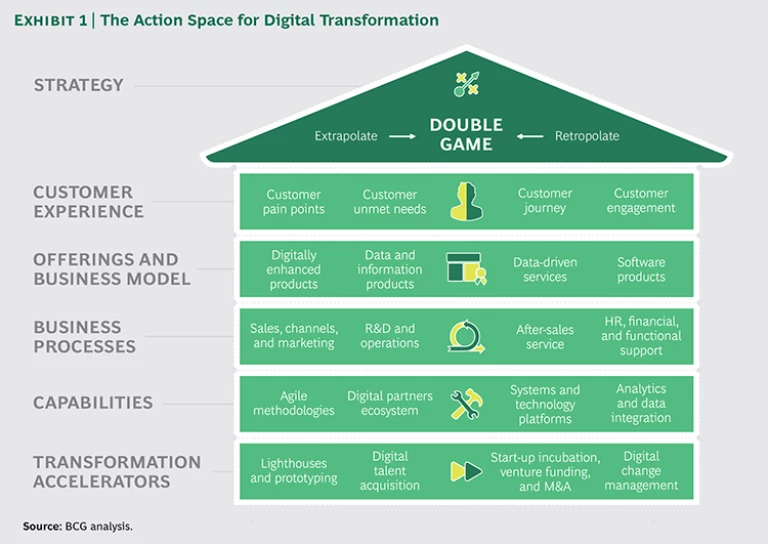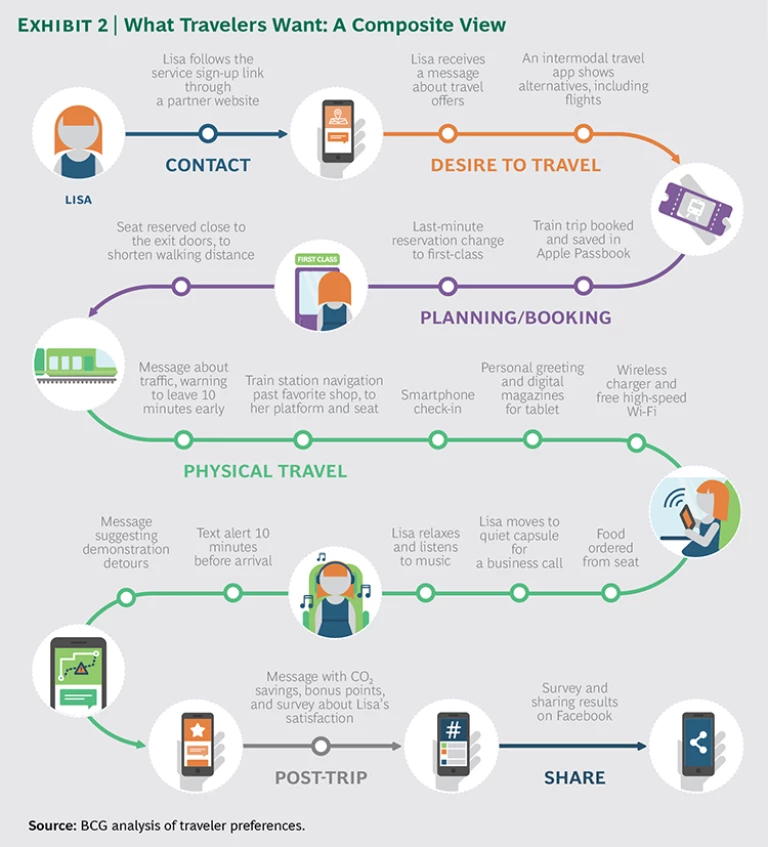This is the second in a series of articles on setting and executing digital strategies with speed, foresight, and savvy. The first article explores how companies can frame and prioritize digital opportunities , while the third article describes how executives should respond to a new era of data-driven management .
Managers are increasingly nervous about the lack of progress in their digital initiatives. Too often, organizations merely add digital “pixie dust” to traditional processes or engage in a frenzy of digital experiments and ventures. Rather than drive competitive advantage, these efforts leave companies more vulnerable.
In the first in our series of publications on digital strategy (see “ The Double Game of Digital Strategy ,” BCG article, October 2015), we laid out an approach—based on making simultaneous long- and short-term moves—to setting strategic priorities in a climate of digital uncertainty. Here we explain how companies across industries can systematically pursue those priorities.
Mapping the Action Space
Digital technologies and approaches are infusing all aspects of the business world. The Internet of Things, ubiquitous connectivity, big data and advanced analytics, the cloud, cognitive computing and artificial intelligence, robotics, and 3D printing are deeply altering nearly all industries. “Mobile first” and social media strategies are essential for success in consumer industries. “Digital twins”—virtual models of physical things that are used to simulate production and maintenance and to provide training—and augmented reality are reshaping the industrial environment.
To create business value, companies can operate in an action space consisting of six interdependent layers. (See Exhibit 1.)
- Defining the strategy focuses on building competitive advantage in the double game. It provides insight into short-term “no regrets” moves as well as more-transformative plays. These decisions establish the path for the other five layers.
- Reshaping the customer experience explores how to eliminate pain points and how to surprise customers with new levels and forms of service today while achieving quantum improvements in customer experience tomorrow.
- Reimagining offerings and business models prepares companies to create novel products and services, often by exploiting new data and powerful analytics.
- Reengineering business processes entails adopting flexible and intuitive digital technologies to simplify processes and increase efficiency.
- Building capabilities, often by working with outside partners and creating new platforms, enables companies to develop new ways of working, new business models, and other building blocks of digital transformation.
- Accelerating the transformation involves devising new approaches to speed up learning, ramp-ups, and transformational plays.
Since we discussed strategy setting in our earlier article, we will now focus on the other five layers, examining each through a case study that highlights best practices and—equally important—potential pitfalls and interdependencies. These examples should challenge your priorities and help you sharpen your approaches. As we demonstrate with two concluding stories, a complete digital transformation requires playing in all six layers.
Reshaping the Customer Experience
Delivering a superior customer experience is a natural initial goal of many digital programs. For example, a toy company interested in designing products that bridge the gap between physical and digital realms started by studying the desires of children, their parents, and retailers. The extensive ethnographic research it conducted combined structured interviews with unstructured creative discovery sessions. The company uncovered a range of unmet needs, from the desire of family members to collaborate on kids’ wish lists online, using a format similar to wedding registries, to the desire of children for even more variety in toy offerings.
The company created online communities and services to strengthen its brand and to raise the level of customer satisfaction. These efforts steered the company toward further improvements in customer interaction, such as offering assembly assistance via smartphone and connecting adults and children through online and mobile communications. The entire program contributed to a significant improvement in sales and profits.
A key challenge in this area is to avoid letting perfection stand in the way of progress. It is more important to launch minimally viable offerings and then to upgrade them quickly in response to customer feedback than to let time and opportunity slip away. Customers have proven to be highly collaborative—accepting initial imperfection and suggesting practical product improvements—when their feedback is acted upon.
Reimagining Offerings and Business Models
New offerings designed to retain or increase the share of wallet of current customers and to win new customers are at the heart of many digital programs. A global manufacturer of farm equipment is seizing the opportunity to make “precision agriculture” possible by introducing digital innovations into a traditional industry.
Recognizing the potential impact of digital on the economics of farming, the company began enhancing its traditional tractors with sensors, software, and displays. Those initial moves are transforming the driver’s cabin into a sophisticated control center capable of analyzing vast amounts of soil quality, irrigation, and other data. A cloud-based analytics platform processes this data along with weather forecasts and historical field records to choose suitable seed mixtures, optimal planting patterns, and the most efficient and cost-effective ways to harvest.
Farmers who employ the new technology are enjoying up to double-digit increases in productivity while using less fertilizer and water. Even greater efficiency gains are on the way as the company prepares for entirely unmanned operations.
A common pitfall in this aspect of digital transformation is the unwillingness of companies to cannibalize their existing business. They limit their powers of imagination and forfeit growth opportunities.
Reengineering Business Processes
In the early days of electrification, companies retained factory layouts built around the original site of the steam engine, even though electricity obviated the need for direct mechanical connections between power generation and power uses.
Today, history is repeating itself. Rather than thinking creatively about how digital technology can support novel approaches to work or production, many companies simply digitize the “belts and pulleys” of legacy processes. Often, however, step changes in efficiency require the building of new processes that rely on smart algorithms and other digital tools.
A major European automotive supplier overcame this challenge by abandoning many fragmented initiatives across production sites and instead strategically reengineering its manufacturing and supply-chain operations. The company’s new strategic direction combined logistics network optimization—almost always the low-hanging fruit in operations—with more-fundamental approaches involving assembly robots and augmented reality.
After only three months, the company started to pilot the most promising short-term initiatives such as logistics tracking. Three months later, it began scaling up the successful pilots across all sites while also addressing the next round of initiatives, leveraging its increasing digital experience base.
Radical process reengineering demands careful strategic workforce planning. In the digital age, such transformation can increase a company’s productivity—but only if the company quickly finds or trains candidates to fill new job profiles that may affect a substantial part of its total workforce. (See Man and Machine in Industry 4.0: How Will Technology Transform the Industrial Workforce Through 2025? , BCG Focus, September 2015.) Without active management of workforce issues, fundamental reengineering will almost certainly stall or even fail.
Building Capabilities
Digital transformation calls for fundamental new capabilities, and these are not easy to build, especially within traditional organizations in industries unaccustomed to rapid change. Utilities, for example, have historically operated in a world of low uncertainty, large economies of scale, stable environments, and predictable returns. Consequently, their focus has been on traditional considerations of efficiency, reliability, and risk avoidance. But times have changed. Pricing and billing are automated. Intermittent renewable-energy sources have entered the picture. Sensors and actuators are proliferating in power-generation equipment and across the entire grid. As a result, utilities and upstarts can take advantage of big data, smart-grid analytics, and cloud computing to improve their methods of generating, distributing, and selling power to customers.
A European utility is striving to become truly customer-centric in this multifaceted, increasingly smart, and renewables-oriented energy world. One of the company’s most critical new capabilities under development is an IT architecture that efficiently handles mass processes such as billing and yet is flexible enough to adapt quickly to changing market demands. In parallel, the utility is creating minimally viable products that it can test and improve in the marketplace while keeping the lights on. To shorten the time to market, the company is relying on lean startup methodologies, prototyping, cross-functional teams, and other agile approaches. Recognizing that it did not possess many of these agile and collaborative skills internally, the utility has been working with outside partners to assist in the transformation and to help embed the new capabilities in the organization.
Playing the double game in this area is challenging because it requires simultaneous action to maintain legacy technologies, embed new digital tools, and introduce a flexible and scalable new digital architecture that will pave the way for an even more radically redefined future. IT departments and external partners can be critical resources in this undertaking, or they can be a hindrance if their specific skill profiles, business practices, and interests do not sync with what is needed—so be prepared.
Accelerating the Transformation
Companies are adopting various practices to accelerate their digital transformation, including rapid prototyping, incubators, M&A, and the acquisition of digital talent, as well as traditional change management levers. (See How to Jump-Start a Digital Transformation , BCG Focus, September 2015.) Many of the most effective accelerators call for new ways of working and new forms of behavior, such as cross-functional, self-directed teams and collaboration built around agile software development methodologies.
A North American pharmaceutical company, for example, adopted a prototyping approach to accelerate digital change. It started by testing initiatives such as search engine optimization and targeted training in the sales and marketing organization. When these improvements led to a 10 to 20 percent reduction in spending for marketing, with no falloff in sales, executives moved on to bigger tasks. To improve the customer interface, the company introduced minimally viable apps that complement specific drugs. The company sees these services as a way to engage with its customers “beyond the pill,” to differentiate its drugs, and to drive growth.
The challenge is that—unlike with traditional transformations—experienced managers are hard to find. Very few executives, for example, have industry experience and deep knowledge in prototyping and agile methodologies. The most successful companies try to make up for this deficiency by emulating the best practices of “digital natives” and engaging in controlled experimentation.
Keep Your Eyes on the Double Game
The elements of digital transformation are, of course, interdependent and mutually reinforcing. A large, state-owned rail and logistics company took a three-tiered approach to digital transformation that illustrates the action space’s many interdependencies and points of overlap. (See Exhibit 2.) First, it redefined the customer experience and implemented new ways to launch and scale up initiatives. Second, it defined a target state of digital transformation ten years in the future. Third, it prepared its people, processes, and offerings for the double game. The company also sent executives on immersion tours to Silicon Valley, created a digital lab, and completed its first digital acquisition.
To redefine the customer experience, the company mapped out the passenger’s journey, from initial travel inspiration through the last mile of the trip and beyond, ending with sharing feedback and memories on social networks. The company also created detailed profiles of business, elderly, and commuter travelers based on its ethnographic interviews and market research. This exercise enabled the company to identify its passengers’ frustrations and unmet needs along the customer journey. Company executives then laid the groundwork for fixes and improvements by using the digital tools at their disposal. They identified more than 400 potential improvements and selected 50 to implement.
The executives recognized that they would have to embark on a huge change-management effort. To encourage managers and employees to become drivers of innovation, they selected five early prototype projects, in order to highlight the positive effects of implementing even small changes.
One prototype, a seat reservation app for commuter rail customers, constituted the company’s first direct digital relationship with these loyal patrons. The app addressed a common complaint of customers—their inability to reserve a seat in commuter trains—but it also opened the way for greater dialogue with the company’s customers. The railroad began field-testing the app 12 weeks after inception; because it relied on a public cloud, the app’s infrastructure costs were one-fifth what the IT department had anticipated.
To accelerate development, the prototype team had to convince traditionalists to waive burdensome company guidelines. In the course of developing the new app-based service, the team also identified structural deficits and inefficiencies in the company’s IT platforms that needed to be addressed.
To minimize the risk of engaging in a series of myopic short-term experiments, the company developed a comprehensive picture of the mobility landscape in 2025 and anticipated product offerings at that time. The exercise allowed the company to “retropolate” from that vision of the future back to the present. In developing this view of the future, executives analyzed the potential impact of self-driving cars, digital intermodal route planning, and other services. As a consequence, they launched a portfolio strategy around new modes of travel and around supplemental intermodal as well as digital services.
While it may be surprising that a state-owned company would undertake these innovations with such energy, it is even more remarkable when an arm of government does so. (See “Turning Digital in Saudi Arabia.”)
TURNING DIGITAL IN SAUDI ARABIA
When Saudi Arabian officials realized several years ago that they were facing persistently high rates of youth unemployment and persistently low rates of female participation in the labor market, they did not even have a network of employment offices to help address the problems.
After benchmarking many systems in Western countries, the Ministry of Labor in Saudi Arabia decided to take a radically new approach. The minister turned the nation’s lack of an installed base into an advantage by going fully digital.
The country introduced an all-online process for applying for unemployment assistance that was designed to minimize human effort. A single SMS message containing the applicant’s government ID number initiates the process—a radical departure from the endless piles of paperwork involved in most traditional systems.
To set up this process, officials introduced a new level of speed and agility in their central organization and built a powerful IT system. For example, they needed to be able to automatically check applicants’ eligibility with dozens of institutions and to collect personal, educational, and employment data.
In arguably the most radical innovation for Saudi Arabia, eligibility was based on the individual’s personal, not family, situation, fundamentally boosting opportunities for women.
At the same time, the ministry designed online training courses to improve the ability of applicants to find a job. To stay eligible for unemployment assistance, applicants had to complete the courses. Within the first 10 weeks, applicants had started 1.8 million courses, ultimately completing more than 90 percent of them. To broaden its selection of courses, the government partnered with accredited private-sector companies to accelerate and tap into the best education programs available globally.
Amazingly, the ministry introduced a smooth customer journey, fast processes, training programs, and strong IT infrastructure, all within eight months. The ministry is now experimenting with customizable, incentive-based training programs instead of purely penalty-based ones. Applicants who qualify, for example, can take highly popular English language courses abroad. In this way, the programs increasingly become personalized to individual job seekers, motivating them with opportunities to earn meaningful rewards.
In the pilot program, activity levels were three to five times higher than in the existing system for more-complex tasks and up to ten times higher for easier tasks. These programs have helped propel a sevenfold increase in the number of women employed in the private sector since 2010.
A Checklist for Action
The following questions may help you set up, prioritize, and execute a digital initiative.
- Do you have an explicit approach for each part of the action space?
- What does your customer journey look like? What are your customers’ known pain points or unmet needs?
- Are there short-term opportunities to enhance current offerings and services? What long-term transformative trends might alter your business model?
- Did you apply digital technologies to achieve radically simplified processes? Have you run pilot projects to improve specific business processes?
- How are you upgrading your digital skills and capabilities to become more agile and to build data analytics teams, tools, and partner ecosystems? In what areas did you consciously decide to develop an in-house capability, and why?
- Did you track and manage your digital initiatives’ interdependencies?
- Have you created a digital roadmap of short- and long-term actions?
- Have you formulated a roadmap of your first set of digital initiatives? How does it fit in with your over-arching digital strategy?
- How and for what reasons do you prioritize resources and time across the layers of the action space?
- Are you accounting for the double game? Where do you trade off short- and long-term actions? Is the focus of your strategy still right?
Playing the double game of digital strategy is inherently challenging. Fortunately, digital not only creates this challenge, but shapes the solution. Many digital technologies have become so intuitive and easy to use that generalists can apply them. In this regard, the technologies have become a bit like e-mail. Managers can lead by example by acquiring and fostering digital skills. After all, some things are too important to be left entirely to the experts.









